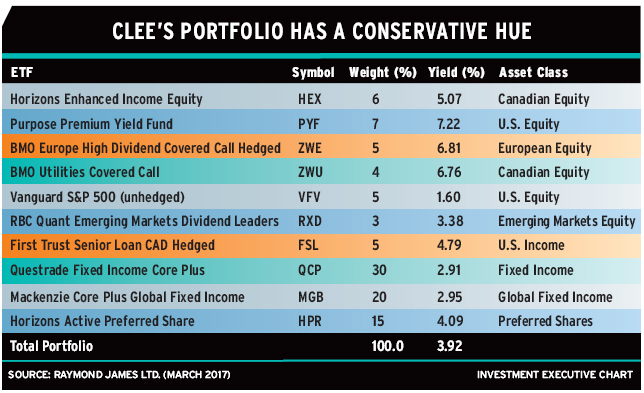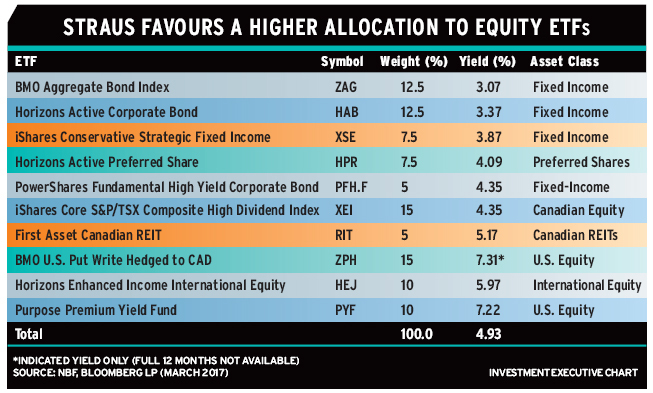
The proliferation of ETFs across numerous asset classes has given advisors the building blocks to construct balanced, low-cost portfolios for clients, using only ETFs.
Investment Executive called upon the expertise of two ETF portfolio strategists – Andrew Clee, a mutual fund/ETF specialist and portfolio manager at Toronto-based Raymond James Ltd.; and Daniel Straus, analyst, ETFs and financial products, at Toronto-based National Bank Financial Inc. – to assemble a model investment portfolio for an imaginary, retired client looking for an income stream.
The criteria: use 10 ETFs, diversify globally, include both equity and fixed-income ETFs and provide an annual yield of roughly 4%. As the exercise turned out, both strategists stuck to ETFs that trade on Canadian exchanges. And, although both strategists included stock and bond ETFs in their recommendations, their weightings are different: Clee allocated a significantly higher amount to fixed-income and preferred shares. Both strategists selected Horizons Active Preferred Share ETF (TSX: HPR), sponsored by Horizons ETFs Management (Canada) Inc., for the slice they allocated to preferred shares.
Both strategists also opted for what Straus labels an “alternative” holding, by choosing Purpose Premium Yield Fund ETF (TSX: PYF), sponsored by Toronto-based Purpose Investments Inc., for their income exposure. This ETF has a healthy current yield of more than 7%. It holds U.S. stocks selected on the basis of quality and value screens, as well as sentiment factors. It also employs an active options strategy, utilizing both “put” and “call” options to augment income and to temper volatility. The fund is unhedged in terms of currency, so it provides exposure to the U.S. dollar.
Andrew Clee: Favouring fixed-income
Clee’s portfolio has a conservative tilt, with a 70% chunk allocated to fixed-income, including 15% to preferred shares. He directed a much smaller slice (30%) to equities.
“We set the asset mix at a 70/30 fixed-income to equities split, with capital preservation and the age of the investor in mind,” Clee says. “We took the fixed-income sleeve a bit high, as we are allocating to Canadian preferred shares within the fixed-income sleeve. Preferreds are more volatile than a traditional bond ETF, but also provide capital appreciation upside in a rising interest-rate environment, unlike other traditional bond products.”
Clee’s biggest weighting is 30% in Questrade Fixed Income Core Plus (TSX: QCP), an actively managed bond ETF sponsored by Questrade Wealth Management Inc. of Toronto and subadvised by Jarislowsky Fraser Ltd. of Montreal. In today’s environment, Clee favours active management in fixed-income over a passive strategy. An active portfolio manager can make choices regarding duration or sector allocation rather than being confined to following a bond-market index.
“With the assumption that yield curves will move higher,” Clee says, “we believe active management will be able to add significant value in the fixed-income space, and we want a [portfolio] manager to have as many tools and levers as possible to add alpha and protect capital.”
In the global space, he chose a 20% holding in actively managed Mackenzie Core Plus Global Fixed Income ETF (TSX: MGB), offered by Mackenzie Financial Corp. of Toronto.
“Just because the North American yield curve is moving higher, that doesn’t mean that rates are on the way up everywhere around the globe,” Clee says. “With the U.S. [Federal Reserve Board] in a tightening cycle, and the Bank of Canada likely to begin [the same trend] in 2018, global bonds are an important source of diversification in the fixed-income sleeve.”
On the equities side, Clee says, roughly two-thirds of his equities sleeve is allocated to ETFs offering covered call strategies for yield pickup and lower volatility. Clee left his U.S. equity positions unhedged, as the U.S. dollar typically performs well in times of equities market stress – when investors gravitate to safe havens, he says. However, he emphasizes, his global bond currency exposure is hedged.
“Unhedged global fixed-income has increased volatility historically,” Clee adds, “not a trait we admire for fixed-income in this type of investor profile.”
Daniel Straus: More equities
Straus allocated a smaller amount to both fixed-income and preferred shares compared to Clee, with 45% in fixed-income (including 7.5% in preferred shares). On the equities side, his allocation was a significantly higher 55%, including 5% in REITs.
Straus’ biggest weightings include 15% in BMO U.S. Put Write (TSX: ZPH), sponsored by Toronto-based BMO Global Asset Management Inc.; and 15% in iShares Core S&P/TSX Composite High Dividend Index ETF (TSX: XEI), sponsored by Toronto-based BlackRock Asset Management Canada Ltd.
Like Clee, Straus chose a handful of ETFs that use put or call options to augment income and reduce overall portfolio volatility. He describes the use of options within ETFs as a “hedge-fund strategy available in an ETF wrapper.”

In addition to Purpose Premium Yield Fund, a holding he shares with Clee, Straus selected BMO U.S. Put Write Hedged to CAD (TSX: ZPH), an ETF that writes put options on U.S. large-cap stocks. In the same vein, he picked Horizons Enhanced Income International Equity ETF (TSX: HEJ), sponsored by Toronto-based Horizons ETFs Management (Canada) Inc., which uses a covered call strategy with international stocks.
“Option-writing ETFs generate more yield than plain-vanilla products, but the downside is that they offer less up-market participation,” Straus says.
“In general,” he adds, “we don’t recommend options-based ETFs for the typical investor. But, for the retiree who has a harder yield target, [these types of ETFs] can provide ways to systematically ‘monetize’ a portfolio.”
© 2017 Investment Executive. All rights reserved.